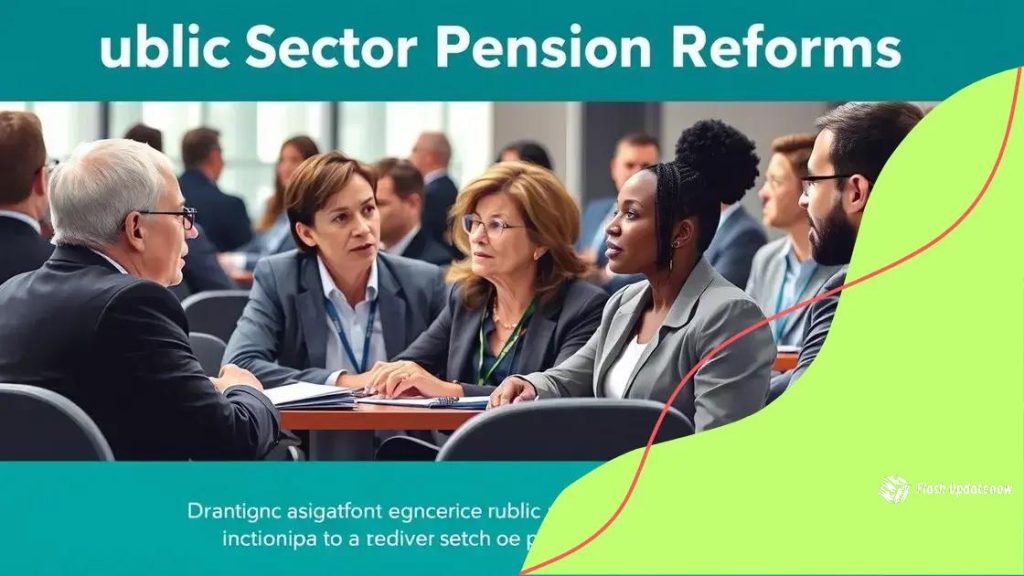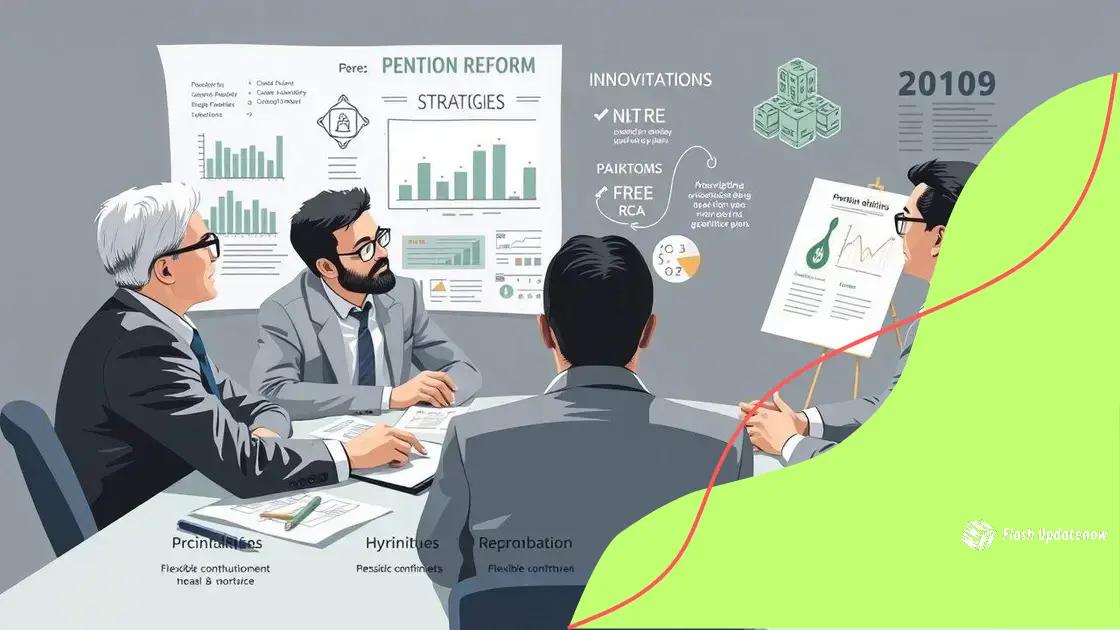Public sector pension reforms: what you need to know

Public sector pension reforms address funding shortfalls and demographic changes by integrating technology, adopting hybrid plans, and emphasizing sustainability to secure financial futures for employees.
Public sector pension reforms are garnering attention as governments strive for sustainable solutions. But what does this mean for you and future retirees? Let’s delve into the changes and implications.
Understanding the current state of public sector pensions
Understanding the current state of public sector pensions is essential for anyone involved in planning for retirement. Public pensions are designed to provide financial security to employees in government jobs, ensuring that they can rely on a steady income post-retirement. However, many challenges are reshaping these systems today.
Key Features of Public Sector Pensions
Public sector pension plans generally share several characteristics that distinguish them from private sector pensions. Some key features include:
- Defined benefit plans, which guarantee a specific payout during retirement.
- Public funding, primarily sourced from taxpayer contributions.
- Eligibility criteria that can vary significantly by state or municipality.
- Cost-of-living adjustments that help maintain purchasing power over time.
These features highlight the commitment to providing reliable retirement benefits to public workers. However, economic factors like increasing life expectancy and budget constraints are putting pressure on these systems. As costs grow, many states are reevaluating their pension plans.
Impact of Financial Pressures
Financial pressures play an important role in shaping pensions. With more retirees living longer, the amount needed to cover their benefits rises. Additionally, market fluctuations can impact pension fund investments, leading to funding shortfalls.
Some common adjustments made by state and local governments to address these issues include increasing employee contribution rates, changing benefit formulas, and even modifying retirement ages. These changes can significantly affect the retirement plans of public sector employees, causing uncertainty about their future benefits.
As the landscape of public sector pensions evolves, understanding these changes and their implications can help employees make informed decisions about their retirement. Awareness of the current challenges is just as important as knowing the benefits. By staying informed, employees can better prepare for the future.
Key challenges facing public sector pension systems
The key challenges facing public sector pension systems are significant and complex. As these systems evolve, they must navigate various obstacles that impact their sustainability and ability to provide benefits. Understanding these challenges is crucial for stakeholders.
Funding Shortfalls
One major challenge is the issue of funding shortfalls. Many public pension plans face deficits due to inadequate contributions and rising costs. As the number of retirees grows, the pressure on pension funds increases. This leads to potential cuts in benefits or increased contributions from current workers.
- Increased longevity of retirees puts additional pressure on funds.
- Economic downturns can reduce investment returns.
- Unexpected expenses can further strain budgets.
As financial pressures mount, states and municipalities are forced to make difficult decisions. Some may increase taxes or redirect funds from other essential services to meet pension obligations. These choices can lead to public discontent and political challenges.
Changing Workforce Demographics
Demographics also play a vital role in shaping public sector pension challenges. As the workforce becomes more diverse and younger generations enter, different expectations about retirement benefits emerge. Younger employees may prefer defined contribution plans rather than traditional pension plans.
Adapting to these changing preferences is crucial for attracting and retaining talent. Additionally, with many public sector employees nearing retirement, the shift in workforce demographics could leave gaps in expertise and experience. This dynamic creates tension between maintaining existing pension structures and modernizing benefits.
As public sector pension systems continue to evolve, it’s essential to recognize these challenges. By understanding funding issues and demographic trends, stakeholders can work towards sustainable solutions that benefit both current and future employees.
Innovative approaches to pension reforms

Innovative approaches to pension reforms are essential for addressing the challenges faced by public sector pension systems. As traditional funding methods show strain, new strategies are emerging to ensure financial sustainability and security for future retirees.
Flexible Contribution Models
One promising approach is the implementation of flexible contribution models. These allow employees to choose their contribution rates based on their financial situation. By providing options, public employees can better prepare for their retirement while ensuring that funds remain adequate.
- Tiered contribution levels based on salary.
- Incentives for higher contributions through matching funds.
- Personalized financial planning tools for employees.
These models empower employees to take charge of their retirement planning. As a result, they can align their contributions with their long-term goals, potentially leading to greater satisfaction in retirement.
Shifting to Hybrid Plans
Another innovative strategy is the adoption of hybrid pension plans. These plans combine the features of defined benefit and defined contribution systems, giving employees the benefits of both while reducing risks for employers.
With hybrid plans, employees can enjoy guaranteed benefits alongside investment growth, offering a more balanced approach to retirement saving. This flexibility allows for greater individual control over retirement funds, making it an appealing option for today’s workforce.
Furthermore, hybrid plans can help stabilize pension systems by sharing the risk between employers and employees. As the workforce evolves, these innovative approaches are vital for adapting pension systems to meet modern needs.
Impact of pension reforms on employees
The impact of pension reforms on employees is significant and multifaceted. As changes to pension systems occur, employees often find themselves adjusting their expectations and financial planning for retirement. Understanding these impacts is vital for current and future employees.
Changes to Benefits
One of the most immediate impacts of pension reforms is the alteration of benefits. Employees may experience reductions in their expected pension payouts or face changes in how benefits are calculated. This can lead to uncertainty and anxiety about their financial future.
- Potential reductions in retirement age eligibility.
- Changes in the formula used to calculate pensions.
- Adjustment of cost-of-living increases.
Employees need to be prepared for these shifts to effectively plan their retirement strategies. Understanding how these changes affect their overall retirement savings is crucial for maintaining financial security.
Employee Contributions
Pension reforms can also lead to increased employee contributions. Many reforms aim to address funding shortfalls by requiring employees to contribute more to their pension plans. While this might ensure the long-term viability of the system, it also impacts disposable income.
When employees pay higher contributions, they must adjust their budgets accordingly. This can create stress, especially for those already living paycheck to paycheck. However, these changes can be beneficial in securing a more stable retirement future.
Additionally, employees may need to rethink their retirement plans. With potential changes in benefits and required contributions, it’s essential for workers to stay informed and proactive about their retirement savings. Engaging with financial planning resources can help them navigate these reforms successfully.
Future trends in public sector pension reforms
Future trends in public sector pension reforms are likely to shape the retirement landscape for many government employees. As various challenges arise, innovations and changes in policies are necessary to ensure the sustainability of pension systems. Understanding these trends can help employees better prepare for their financial futures.
Emphasis on Sustainability
One prominent trend is the increasing emphasis on sustainability. Governments are recognizing the need to create pension systems that can withstand economic fluctuations. This involves not only funding stability but also implementing practices that promote long-term growth.
- Incorporating environmental, social, and governance (ESG) factors into investment strategies.
- Using technology to improve administrative efficiency.
- Enhancing transparency to build trust among beneficiaries.
These measures can help ensure that pension funds remain viable while also appealing to socially-conscious employees.
Integration of Technology
Another major trend is the integration of technology in pension management. Digital tools are making it easier for employees to access information about their retirement plans. This includes online portals for managing contributions, tracking investments, and understanding available benefits.
Moreover, data analytics can optimize pension fund performance by identifying investment opportunities and risks. By leveraging technology, public sector pension systems can improve efficiency while enhancing the user experience for employees.
Shift Towards Hybrid Plans
The shift towards hybrid pension plans is also expected to continue. These plans combine features of traditional defined benefit plans with defined contribution plans. This approach allows for more flexibility, which can be appealing to younger employees entering the workforce.
Such plans help distribute risk between employers and employees while ensuring adequate retirement income. As preferences among workers change, hybrid plans may become the norm, adapting to the diverse needs of a multi-generational workforce.
As public sector pension reforms evolve, staying informed about these future trends will help employees make better choices for their retirement planning.
In conclusion, the landscape of public sector pension reforms is evolving rapidly. As we navigate challenges like funding shortfalls, demographic shifts, and the need for sustainable practices, it is crucial for employees to stay informed. Understanding future trends, including technology integration and flexible pension plans, will empower employees to make better retirement choices. By adapting to these changes, public sector workers can prepare for a more secure financial future.
FAQ – Frequently Asked Questions about Public Sector Pension Reforms
What are the key challenges facing public sector pension systems?
Key challenges include funding shortfalls, rising costs due to increased longevity, and changing workforce demographics.
How do pension reforms impact employees?
Pension reforms can lead to changes in benefits, increased contribution rates, and adjustments in retirement expectations.
What innovative approaches are being used for pension reforms?
Innovative approaches include flexible contribution models and the adoption of hybrid pension plans that combine different benefit structures.
Why is technology important in managing pension systems?
Technology enhances efficiency, improves transparency, and provides employees better access to their retirement information.
